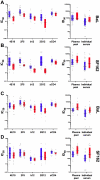The role of natural killer (NK) cells and NK cell receptor polymorphisms in the assessment of HIV-1 neutralization
- PMID: 22509241
- PMCID: PMC3324450
- DOI: 10.1371/journal.pone.0029454
The role of natural killer (NK) cells and NK cell receptor polymorphisms in the assessment of HIV-1 neutralization
Abstract
The importance of innate immune cells in HIV-1 pathogenesis and protection has been highlighted by the role of natural killer (NK) cells in the containment of viral replication. Use of peripheral blood mononuclear cells (PBMC) in immunologic studies provides both HIV-1 target cells (ie. CD4+ T cells), as well as anti-HIV-1 effector cells, such as NK cells. In this study, NK and other immune cell populations were analyzed in HIV-negative donor PBMC for an impact on the anti-HIV activity of polyclonal and monoclonal antibodies. NK cell percentages were significantly higher in donor PBMC that supported lower levels of viral replication. While the percentage of NK cells was not directly associated with neutralization titers, NK cell-depletion significantly diminished the antiviral antibody activity by up to three logs, and polymorphisms in NK killer immunoglobulin receptor (KIR) and FcγRIIIa alleles appear to be associated with this affect. These findings demonstrate that NK cells and NK cell receptor polymorphisms may influence assessment of traditional HIV-1 neutralization in a platform where antibody is continuously present. This format appears to simultaneously assess conventional entry inhibition (neutralization) and non-neutralizing antibody-dependent HIV inhibition, which may provide the opportunity to delineate the dominant antibody function(s) in polyclonal vaccine responses.
Conflict of interest statement
Figures








Similar articles
-
Role of natural killer cells in a cohort of elite suppressors: low frequency of the protective KIR3DS1 allele and limited inhibition of human immunodeficiency virus type 1 replication in vitro.J Virol. 2009 May;83(10):5028-34. doi: 10.1128/JVI.02551-08. Epub 2009 Feb 11. J Virol. 2009. PMID: 19211742 Free PMC article.
-
HIV-1 adaptation to NK-cell-mediated immune pressure.Nature. 2011 Aug 3;476(7358):96-100. doi: 10.1038/nature10237. Nature. 2011. PMID: 21814282 Free PMC article.
-
HLA-F on Autologous HIV-Infected Cells Activates Primary NK Cells Expressing the Activating Killer Immunoglobulin-Like Receptor KIR3DS1.J Virol. 2019 Aug 28;93(18):e00933-19. doi: 10.1128/JVI.00933-19. Print 2019 Sep 15. J Virol. 2019. PMID: 31270222 Free PMC article.
-
Natural killer (NK) cell receptor-HLA ligand genotype combinations associated with protection from HIV infection: investigation of how protective genotypes influence anti HIV NK cell functions.AIDS Res Ther. 2017 Sep 12;14(1):38. doi: 10.1186/s12981-017-0172-9. AIDS Res Ther. 2017. PMID: 28893287 Free PMC article. Review.
-
The role of NK cells in HIV-1 protection: autologous, allogeneic or both?AIDS Res Ther. 2016 Mar 18;13:15. doi: 10.1186/s12981-016-0099-6. eCollection 2016. AIDS Res Ther. 2016. PMID: 26997965 Free PMC article. Review.
Cited by
-
Distinctive Responses in an In Vitro Human Dendritic Cell-Based System upon Stimulation with Different Influenza Vaccine Formulations.Vaccines (Basel). 2017 Aug 9;5(3):21. doi: 10.3390/vaccines5030021. Vaccines (Basel). 2017. PMID: 28792466 Free PMC article.
-
Three-Year Durability of Immune Responses Induced by HIV-DNA and HIV-Modified Vaccinia Virus Ankara and Effect of a Late HIV-Modified Vaccinia Virus Ankara Boost in Tanzanian Volunteers.AIDS Res Hum Retroviruses. 2017 Aug;33(8):880-888. doi: 10.1089/AID.2016.0251. Epub 2017 Jan 27. AIDS Res Hum Retroviruses. 2017. PMID: 28027665 Free PMC article.
-
Impact of HIV-1 backbone on neutralization sensitivity: neutralization profiles of heterologous envelope glycoproteins expressed in native subtype C and CRF01_AE backbone.PLoS One. 2013 Nov 29;8(11):e76104. doi: 10.1371/journal.pone.0076104. eCollection 2013. PLoS One. 2013. PMID: 24312165 Free PMC article.
-
The Vaginal Acquisition and Dissemination of HIV-1 Infection in a Novel Transgenic Mouse Model Is Facilitated by Coinfection with Herpes Simplex Virus 2 and Is Inhibited by Microbicide Treatment.J Virol. 2015 Sep;89(18):9559-70. doi: 10.1128/JVI.01326-15. Epub 2015 Jul 8. J Virol. 2015. PMID: 26157126 Free PMC article.
-
Optimized Replicating Renilla Luciferase Reporter HIV-1 Utilizing Novel Internal Ribosome Entry Site Elements for Native Nef Expression and Function.AIDS Res Hum Retroviruses. 2015 Dec;31(12):1278-96. doi: 10.1089/aid.2015.0074. Epub 2015 Jun 23. AIDS Res Hum Retroviruses. 2015. PMID: 26101895 Free PMC article.
References
-
- Rerks-Ngarm S, Pitisuttithum P, Nitayaphan S, Kaewkungwal J, Chiu J, et al. Vaccination with ALVAC and AIDSVAX to prevent HIV-1 infection in Thailand. N Engl J Med. 2009;361:2209–2220. - PubMed
-
- Thongcharoen P, Suriyanon V, Paris RM, Khamboonruang C, de Souza MS, et al. A Phase 1/2 Comparative Vaccine Trial of the Safety and Immunogenicity of a CRF01_AE (Subtype E) Candidate Vaccine: ALVAC-HIV (vCP1521) Prime With Oligomeric gp160 (92TH023/LAI-DID) or Bivalent gp120 (CM235/SF2) Boost. J Acquir Immune Defic Syndr. 2007;46:48–55. - PubMed
-
- Pitisuttithum P, Berman PW, Phonrat B, Suntharasamai P, Raktham S, et al. Phase I/II study of a candidate vaccine designed against the B and E subtypes of HIV-1. J Acquir Immune Defic Syndr. 2004;37:1160–1165. - PubMed
-
- Pitisuttithum P, Nitayaphan S, Thongcharoen P, Khamboonruang C, Kim J, et al. Safety and immunogenicity of combinations of recombinant subtype E and B human immunodeficiency virus type 1 envelope glycoprotein 120 vaccines in healthy Thai adults. J Infect Dis. 2003;188:219–227. - PubMed
-
- Stamatatos L, Morris L, Burton DR, Mascola JR. Neutralizing antibodies generated during natural HIV-1 infection: good news for an HIV-1 vaccine? Nat Med. 2009;15:866–870. - PubMed
Publication types
MeSH terms
Substances
Grants and funding
LinkOut - more resources
Full Text Sources
Research Materials

